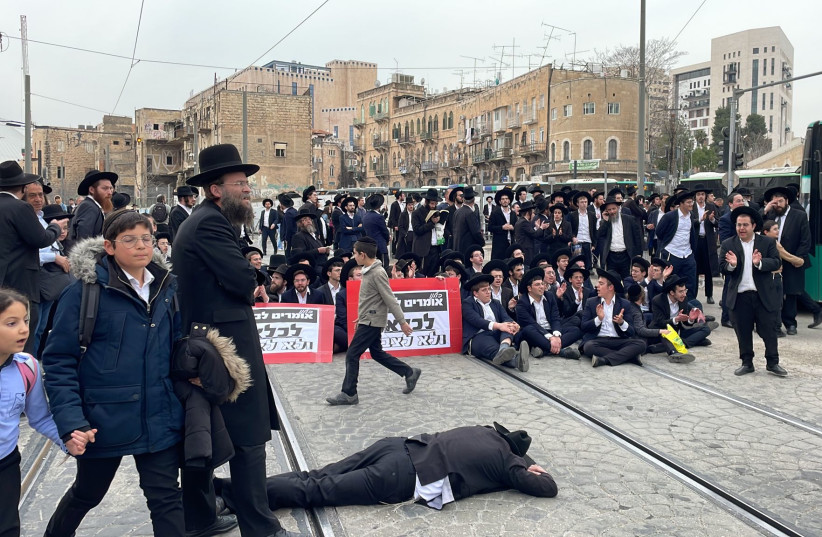Haredi MKs have acknowledged, behind closed doors, that a significant increase in haredi enlistment into the IDF is only possible if the parties remain out of government for a sustained period, Yesh Atid MK Moshe Tur-Paz said in an interview with The Jerusalem Post on Wednesday.
The interview took place ahead of an important High Court of Justice hearing on June 2, which will determine whether to turn from temporary to permanent a ruling that the IDF is required to begin recruiting all haredi men of military age. The legal basis to exempt them expired last year, on July 1.
According to Tur-Paz – a former yeshiva student, high school educator, IDF reserve battalion commander, and Yesh Atid’s leading liaison to Israel’s ultra-Orthodox parties – haredi MKs admitted in conversations with him that between one-third and one-half of military-age haredi men do not actually study in yeshivot (Torah study academies), and thus, if they are drafted to the IDF, the world of Torah study would not be harmed. Rather, the haredi MK’s chief concern is secularization; he worries that young haredi men will not be able to maintain their lifestyle during IDF service.
Why are the haredim unwilling to draft?
According to Tur-Paz, the majority of haredim believe that Torah study protects Israel to the same degree as military service and are unwilling to join the IDF. Haredi constituents will not accept a move by their representatives in the Knesset to push for IDF service, and the haredi MKs themselves acknowledged that for real change to happen, it must be when they are outside of the government.

This proved to be true in the past, Tur-Paz noted. The two most recent governments that did not include the haredi parties were the ones that took significant steps on the issue.
In 2022, the Lapid-Bennett government succeeded in passing the first reading of a new bill that would incentivize haredim both to join the IDF and the workforce, and in 2014, the Netanyahu-Lapid-Bennett government passed a bill that included criminal sanctions for haredi draft-dodgers, which soon led to an increase in haredi draftees.
However, when the haredi parties returned to the government in 2015, they amended the bill, leading to a decrease in the number of haredi draftees.
Who are the haredi parties?
The hardi parties are diverse and include several major groups and dozens of smaller ones. There are only two haredi parties in the Knesset – the Sephardi Shas party and the Ashkenazi United Torah Judaism party (UTJ). UTJ itself includes two factions: the Lithuanian Degel Hatorah, led by MK Moshe Gafni, and the hassidic Agudat Yisrael, led by Construction Minister Yitzhak Goldknopf.
Furthermore, within Agudat Yisrael itself, each Knesset member represents a different hassidic community. Goldknopf comes from Hassidut Gur; Jerusalem Affairs and Jewish Tradition Minister Meir Porush represents a coalition of smaller hassidic groups called Shlomei Emunim; Deputy Culture and Sports Minister MK Yaakov Tessler represents Hassidut Vishnitz; etc.
According to Tur-Paz, each faction within the haredi world has a different attitude towards the question of the IDF draft. The haredi MKs who acknowledged that one-third to a half of haredi men do not study in yeshivot belong to the Lithuanian Degel Hatorah faction, whose representatives have largely been silent in public regarding the haredi conscription issue.
Shas is considered, in general, to be a more moderate party than UTJ. Some of its members served in the IDF themselves. However, according to Tur-Paz, Shas is more concerned than Degel Hatorah over the conscription bill. The reason is that more of Shas’s constituents are part of the workforce and fewer are registered as yeshiva students. Therefore, in the case of a conscription bill that includes a requisite minimum of thousands of haredi draftees, a disproportionate amount will come from Shas, Tur-Paz explained.
The impact of the war on haredi draft
The hassidic groups are the most ideologically bent against any IDF service and likely will put up the most resistance, Tur-Paz said.
He added that since the outbreak of the Israel-Hamas war on October 7, the haredi street has been more accepting of IDF soldiers in general, but unfortunately, they have not indicated a willingness to join the IDF. Economic and criminal sanctions against draft dodgers have worked in the past, and Tur-Paz argued that a combination of political, legislative, and economic pressure would be required to create real change. He said that he was optimistic because, unlike in the past, today there simply is “no other choice” – the IDF needs to swell its ranks with thousands of combat soldiers, and the only available Jewish manpower pool is that of haredi men.
In 2014 and 2016, Tur-Paz was involved in forming two haredi combat units – the Givati and Paratrooper brigades. According to Tur-Paz, there are currently four haredi yeshivot, comprising approximately 500 students, that incorporate IDF service under the “hesder” model, a model developed by religious-Zionists and where Tur-Paz himself began his military service.
The model enables religious soldiers to serve in a socially homogenous unit that takes their lifestyle into account. For example, Tur-Paz said, a rabbi from his yeshiva would visit the unit once a month. The model simply needed to expand to accommodate the thousands more soldiers that the IDF requires, rather than incorporating new arrangements.
He acknowledged that haredi units will require some additional adaptations to accommodate their lifestyle, but the existing haredi units have proven that it is possible.
